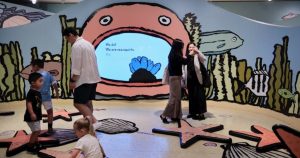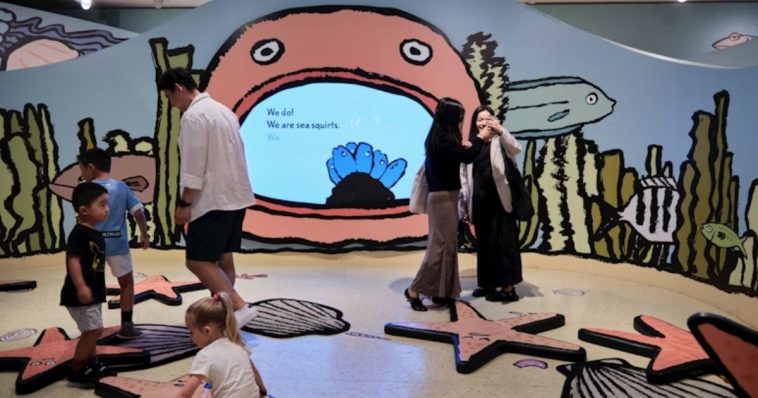Visiting museums and attractions doesn’t have to feel like homework for kids. With the right mix of interactive exhibits, playful learning, and immersive experiences, children can explore the world in a way that sparks curiosity, creativity, and lifelong learning. From science and art to history and wildlife, this guide encompasses every type of kid-friendly museum.
Top Kid-Friendly Museums & Fun Attractions for Families

1. Hands-On Science and Discovery Museums
Science museums are playgrounds for curiosity. Kids can experiment, touch, build, and explore, making learning a tangible and enjoyable experience.
Top Science Museums Around the World
-
Exploratorium (San Francisco, USA) – Over 600 interactive exhibits spanning physics, biology, and perception, including the famous Tactile Dome.
-
Science Museum (London, UK) – Features “Wonderlab,” where kids can conduct experiments and enjoy live demonstrations.
-
Ontario Science Centre (Toronto, Canada) – Hands-on exhibits and IMAX films make science immersive for all ages.
-
Deutsches Museum (Munich, Germany) – Offers kid-friendly experiments in technology, energy, and transportation.
-
Miraikan – The National Museum of Emerging Science and Innovation (Tokyo, Japan) – Explores cutting-edge technology, robotics, and space science.
Pro Tips:
-
Check for workshops, live demos, or special events—these create unforgettable experiences.
-
Target age-appropriate zones; toddlers may enjoy water play areas, while older kids can handle robotics labs.
-
Bring a notebook for kids to record their experiments or discoveries—it doubles as a keepsake of their memories.
2. Art Museums with Interactive Programs
Art can be magical when children participate, rather than just observe. Museums now often include programs, scavenger hunts, or craft zones.
Must-Visit Kid-Friendly Art Museums
-
Children’s Museum of the Arts (New York, USA) – Workshops in painting, sculpture, and digital arts.
-
Van Gogh Museum (Amsterdam, Netherlands) – Family-friendly tours, art trails, and interactive drawing tools.
-
National Gallery of Art (Washington, D.C., USA) – Provides sketching stations, scavenger hunts, and storytelling sessions.
-
Centre Pompidou (Paris, France) – Offers workshops, family guides, and hands-on multimedia exhibits.
-
Louvre Museum – Family Trails (Paris, France) – Engaging tours designed to introduce kids to iconic artworks without feeling overwhelming.
Parent Tips:
-
Short, structured visits are most effective; consider visiting one gallery per trip.
-
Bring sketchbooks or craft materials to encourage creativity beyond the exhibits.
-
Participate with your child—it makes the experience interactive and memorable.
3. History Museums That Engage and Entertain
History comes alive when kids can see, touch, and experience the past. Look for museums with interactive exhibits or live reenactments.
Top History Museums and Living History Sites
-
Colonial Williamsburg (Virginia, USA) – Reenactors, historic houses, and horse-drawn carriages.
-
The British Museum (London, UK) – Offers family trails and digital interactive displays for ancient civilizations.
-
German Open-Air Museums (Germany) – Try crafts, historic games, and explore authentic village life.
-
Vasa Museum (Stockholm, Sweden) – Features a 17th-century ship with immersive storytelling for kids.
-
Fortress of Louisbourg (Nova Scotia, Canada) – A living history museum where children can meet costumed interpreters and try historical activities.
Pro Tips:
-
Encourage dress-up or role-playing to make history tangible.
-
Focus on specific sections to prevent overload.
-
Capture moments with photos, but involve kids in storytelling to enhance engagement.
4. Nature, Wildlife, and Eco-Attractions
Kids have an innate curiosity about animals and the natural world. Zoos, aquariums, and botanical gardens are perfect for experiential learning.
Recommended Nature Experiences
-
San Diego Zoo & Safari Park (California, USA) – Combines traditional zoo exhibits with safari experiences.
-
Monterey Bay Aquarium (California, USA) – Touch pools, jellyfish displays, and marine animal feedings.
-
Singapore Botanic Gardens – Themed gardens, guided tours, and rainforest explorations.
-
Loro Parque (Tenerife, Spain) – Tropical birds, marine life shows, and conservation programs.
-
Taronga Zoo (Sydney, Australia) – Close encounters with animals, plus conservation workshops for kids.
Tips for Parents:
-
Time visits around feeding sessions—they’re interactive highlights.
-
Bring hats, sunscreen, and water for comfort.
-
Encourage kids to keep a “nature journal” to record observations.
5. Indoor Discovery Centers and Play Museums
Rainy days or high-energy kids call for indoor attractions designed for exploration and hands-on learning.
Popular Indoor Play and Discovery Centers
-
Boston Children’s Museum (Massachusetts, USA) – Engaging exhibits in science, culture, and art.
-
LEGOLAND Discovery Centers (Multiple Worldwide) – LEGO-themed interactive worlds, building stations, and rides.
-
Eureka! The National Children’s Museum (Halifax, UK) – STEM-focused, hands-on learning for different age groups.
-
KidZania (Multiple Worldwide) – A miniature city where kids role-play careers like doctors, pilots, or firefighters.
-
Children’s Museum of Indianapolis (Indiana, USA) – Includes dinosaur exhibits, space exploration, and interactive art stations.
Parent Tips:
-
Comfortable, washable clothing is a must; kids get messy while creating.
-
Allocate 2–3 hours to explore fully.
-
Take advantage of parent zones or seating areas for breaks.
6. Zoos, Farms, and Animal Sanctuaries
Petting animals, observing wildlife, and learning about ecosystems instill empathy and awareness in children.
Noteworthy Animal Experiences
-
The Gentle Barn (California, USA) – Safe interactions with rescued animals and educational programs.
-
Farm Park Experiences (Multiple Locations) – Milking cows, collecting eggs, and hands-on agricultural lessons.
-
Zoo Atlanta (Georgia, USA) – Combines traditional exhibits with interactive conservation activities.
-
Edinburgh Zoo (Scotland, UK) – Giant pandas, penguin parades, and immersive exhibits.
-
Ouwehands Zoo (Netherlands) – Special children’s areas and animal feeding experiences.
Tips for Parents:
-
Align visits with scheduled interactive sessions for maximum engagement.
-
Teach kids animal behavior and respect beforehand.
-
Bring wipes and spare clothing—it gets messy!
7. Technology, Robotics, and Space Exploration
For kids fascinated by technology, interactive hubs provide an opportunity to explore innovation, robotics, coding, and outer space.
Must-Visit Tech Museums
-
Space Center Houston (Texas, USA) – Astronaut simulations, spacecraft exhibits, and space missions.
-
Tech Museum of Innovation (San Jose, USA) – Robotics labs, virtual reality, and hands-on engineering activities.
-
Miraikan (Tokyo, Japan) – Cutting-edge robotics, space exploration, and AI exhibits.
-
Ontario Science Centre (Toronto, Canada) – Features interactive technology labs for coding and robotics.
-
Cité des Sciences et de l’Industrie (Paris, France) – Hands-on science, technology, and engineering for kids of all ages.
Pro Tips:
-
Encourage problem-solving challenges—they naturally promote STEM skills.
-
Combine museum visits with online or app-based games for continued learning.
-
Limit visit duration to prevent overwhelm from intense tech experiences.
8. Seasonal and Festival-Based Attractions
Many attractions only appear during certain seasons, but they can be both memorable and kid-friendly.
Examples of Seasonal Fun
-
Holiday Markets with Children’s Sections (Europe) – Christmas markets in Germany, France, or Austria often feature workshops, rides, and storytelling sessions.
-
Tulip Festivals (Netherlands, USA) – Kids can explore colorful gardens and nature trails.
-
Pumpkin Patches and Corn Mazes (USA) – Hands-on agricultural activities with seasonal fun.
-
Summer Science Camps and Museum Programs (Worldwide) – Short-term workshops in art, science, and history.
Tips for Parents:
-
Check online calendars before planning your trip.
-
Seasonal attractions are often crowded—book tickets early.
-
Encourage children to document their experiences with photos or journals.
Travel Tips for Visiting Kid-Friendly Museums

A successful family museum visit takes more than just showing up—it’s all about planning, pacing, and engagement. With a little strategy, you can turn a museum trip into a fun, educational adventure that kids will actually look forward to. Here’s how to make the most of your visit:
Prioritize Interactive Exhibits
Children learn best when they can touch, play, and experiment rather than just observe. Look for museums that feature hands-on activities like touchable artifacts, science stations, or art corners where kids can create their own masterpieces. These areas keep children engaged, turning passive learning into active discovery.
Keep It Short and Focused
Museums can be overwhelming, especially for young kids with shorter attention spans. Instead of trying to cover everything, pick a few key exhibits that match your child’s interests. Plan for breaks in between—whether it’s a snack, a quick rest, or some outdoor play—to keep energy levels high and meltdowns at bay.
Check Age Recommendations
Not all exhibits are designed with every age group in mind. Some may be too advanced, while others are too fragile for curious little hands to handle. Checking age suitability ahead of time prevents frustration and ensures that your child gets the most out of their visit, whether they’re a toddler or a teenager.
Use Audio Guides, Apps, or Scavenger Hunts
Many museums now offer family-friendly digital tools, such as audio tours, interactive apps, or scavenger hunt activities. These add an element of play and competition, encouraging kids to engage more deeply with the exhibits. Solving puzzles, finding hidden objects, or following themed trails can turn the visit into an adventure.
Pack Essentials
A small backpack stocked with snacks, water, wipes, and a change of clothes is a lifesaver. Kids are more likely to enjoy themselves when they’re comfortable, fed, and clean. These little essentials can make the difference between a smooth outing and a stressful one.
Encourage Questions and Conversation
Museums are more fun when kids feel involved. Ask them what they think about an exhibit, encourage them to share their observations, or connect the displays to something they’ve seen in daily life. These conversations not only spark curiosity but also strengthen the family bond through shared learning.
Choose the Right Time to Visit
Timing can make or break a museum trip. Visiting during off-peak hours—such as weekday mornings or late afternoons—means fewer crowds and a calmer atmosphere. This gives children more space to explore and more time to interact with the exhibits without feeling rushed.
Take Photos, But Don’t Distract
It’s tempting to document every moment, but snapping too many photos can take away from the experience. Focus first on letting kids immerse themselves in what they’re seeing. Once they’ve had their fill, then capture a few shots to remember the day.
Plan for Post-Museum Reflection
The learning doesn’t have to end when you leave. At home, ask your kids about their favorite parts of the visit, create art inspired by the exhibits, or even watch a related documentary together. This reflection reinforces what they learned and helps transform the museum trip into a lasting memory.
Making Memories Through Kid-Friendly Adventures
Kid-friendly museums and attractions offer more than just entertainment—they are gateways to curiosity, discovery, and creativity. Whether your child loves science, art, animals, or history, there’s a perfect attraction to inspire them. With thoughtful planning, these experiences become cherished family adventures that leave lasting memories.



